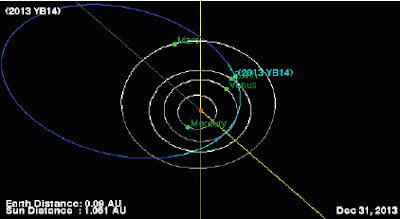The asteroid 2013 YB14 passed by the Earth at a distance of 7 378 000 km (slightly under 19.2 times the distance between the Earth and the Moon) a little before 6.55 am on Tuesday 24 December 2013 (Christmas Eve). There was no danger of the asteroid hitting us, though had it done so it would have presented a realistic risk. 2013 YB14 is estimated to be between 52 and 160 m in diameter, and an object towards the upper end of this range would be expected to punch straight through the Earth's atmosphere and impact the ground, resulting in an explosion over 45 000 times as powerful as the Hiroshima bomb, which would create a crater in excess of 2.5 km in diameter and lead to devastation over a wide area, as well as climatic effects that would last for years.
The calculated orbit of 2013 YB14. JPL Small Body Database Browser.
2013 YB14 was discovered on 26 December 2013 (Boxing Day, two days after its closest pass to the Earth) by the University of Arizona's Catalina Sky Survey in the Catalina Mountains north of Tucson. The designation 2013 YB14 implies that it was the 352nd asteroid discovered in the second half of December 2013 (period 2013 Y).
2013 YB14 has a 3.91 year orbital period and an eccentric orbit that takes it from 0.73 AU from the Sun (i.e. 73% of the average distance at which the Earth orbits the Sun, inside the orbit of Venus) to 4.23 AU from the Sun (i.e. 423% of the average distance at which the Earth orbits the Sun, considerably more than twice the distance at which Mars orbits the Sun). It is therefore classed as an Apollo Group Asteroid (an asteroid that is on average further from the Sun than the Earth, but which does get closer).
See also Asteroid 2013 YB, Asteroid 2012 CL19 passes the Earth, Asteroid 2013 XG17 passes the Earth, Asteroid 2013 XU21 passes the Earth and Asteroid 2013 WV43 passes the Earth.
Follow Sciency Thoughts on Facebook.

